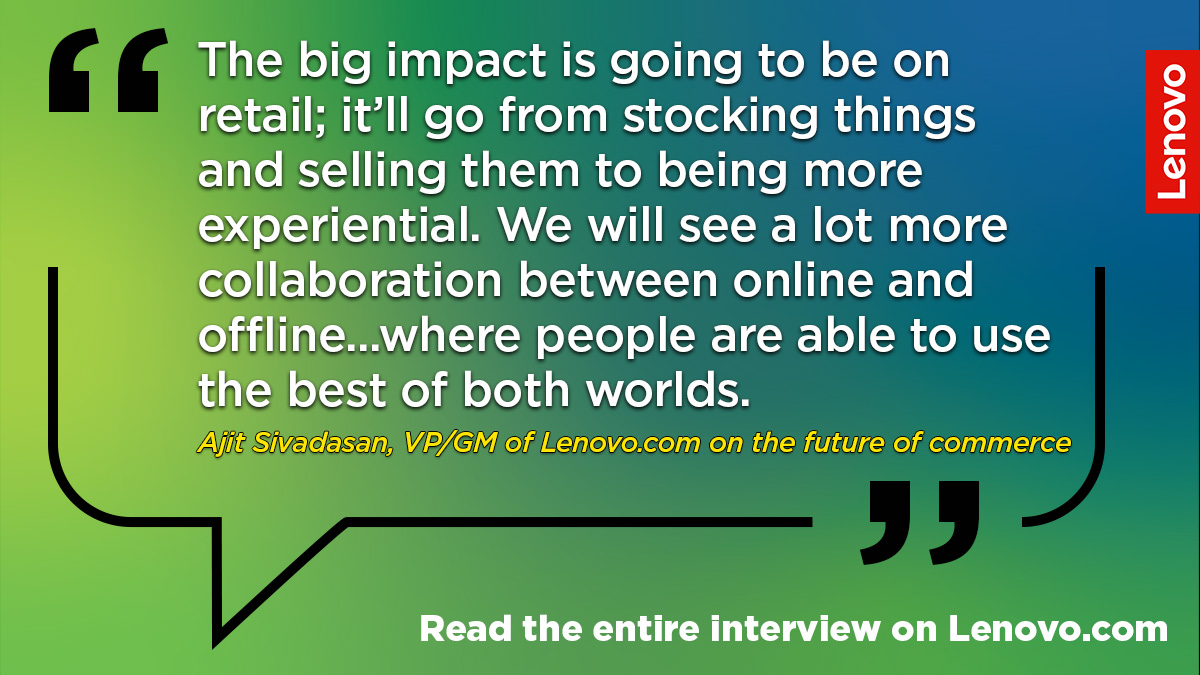As Global Head, Vice President, and General Manager of eCommerce at Lenovo, Ajit Sivadasan is focused on managing the customer’s experience with the brand as well as the purchasing experience on Lenovo.com. We sat down with Ajit to ask him about Lenovo’s experience over the past year and what challenges and opportunities lie ahead.
Q: There’s no denying that 2020 was a year unlike any other for all people and all businesses, but let’s start on a positive note. What do you believe were successes in 2020 for Lenovo.com that will be built upon in 2021?
The current crisis meant that people were able to experience brands much more digitally and be more connected with them online. When many countries and states were in lockdown and people just couldn’t go out, it pushed digital transformation forward. We have seen how essential technology is to help people be productive in their daily lives and work, whether they are students, small business owners, or people who work full-time for a company.
I think it’s a pivotal moment for society. Everybody was adopting technology at their own pace, but now they had to leapfrog into this new world where they are going to be much more digitally connected with everything they want to do, from running their household to helping their kids’ education to working for a living. A lot of companies are shifting their business models to accommodate this “new normal.” I think we’re seeing a lot of innovation coming because there’s a new, unmet demand for brands to be innovative so they can reach their customers in a different way online.
Q: What were the biggest challenges that your team faced in 2020? How have you been able to overcome those challenges, or what is your plan for overcoming them in 2021?
The biggest challenge everybody is facing is significant disruption on the supply chain side. I think everybody understands the challenges of digital transformation when it comes to meeting customers’ needs, and everybody adjusted in terms of creating websites, creating accessibility, and looking at digital investments. But the entire supply chain that feeds product manufacturing — that gets product from point A to point B — is still constrained because of the challenges many countries and states face. People can’t be in a manufacturing facility 24/7; people can’t meet at scale to do what’s required in certain industries. And it’s affecting product availability.
The other challenge we see is that there is a group of people who have never used online access as much as they do now. Brands and people need to look at new things we need to do to educate users who are new to online, and to really consider the challenges those people face.
We have to find ways to be more inclusive with design and usability. How to simplify a user interface; how to design to help people to get information they can easily understand, rather than trying to appeal to just the early adopters and people who have a very sophisticated understanding of technology. There are more people, and different people, using our websites and our mobile interface, and we need to make it easier for them.
We also have to consider the new use cases that have come about. When we talk about kids studying from home, or people working from home on video chat or conference calls for 10 hours straight, we have to think about the ergonomics of the products that we make: the type of lighting they use, the screens that we design.
People are using technology products much longer, things that were not designed to be used for 10 hours straight over six months, eight months, or a year. That’s forcing companies like us to really think about how to design something that is friendly for students. How do we make sure we’re considering the ergonomic impacts on their eyes and their backs? How do we design better hardware that meets the new needs of people who are using our products differently?
Q: As we ride out the rest of COVID-19 and finally start to embrace a post-pandemic life more familiar to us, what tech trends are you expecting to see take place in 2021?
I think the big impact is going to be on retail; it’ll go from stocking things and selling them to being more experiential. We will see a lot more collaboration between online and offline, and the experience will become much more omnichannel, where people are able to use the best of both worlds.
Another area for innovation will be solutions for how customers are working or studying from home. You’ll also see more innovation around how people pay for things. We already see that with subscriptions, with people and small businesses paying on a monthly basis or as they go, rather than buying hardware or other things as a one-time purchase.
Q: What will be your main focus or goals for Lenovo.com in 2021?
Increasingly, we are trying to get closer to our customers to become much more of a solution and experience provider. In the past, we would have said you need a computer for your schoolwork or your work, so here’s a product to buy. We are realizing that it’s on us to really think about how people are going to use these products and the environment they will use them in.
We want to build a deeper relationship with our customers, whether they’re SMBs or students or gamers. We want to provide end-to-end solutions so they get more from their investment in the hardware across their whole ecosystem, but at the same time connect them with content and other people, as part of a community, to help them get more out of their purchases.
We’ve been talking about this for a while, but COVID has forced us to start thinking much more about a customer-centric approach to how we design and sell products. From a web standpoint, it’s also how we connect all the dots to give the customer a holistic experience, beyond just making a purchase.

Q: What do you believe the future of work will look like, and do you think the workplace will continue to evolve? What’s been fueling the changes that have happened and that you see coming?
I think people now realize that not everybody has to be at work every single day in an office to be productive. People have basically not been to offices in the last eight or nine months, and businesses have continued to do well; in some cases, they’ve thrived.
Many companies already plan to enable employees to work where they see fit; people will definitely go to work in an office, but it may not be every day of the week. I think that’s a good thing for people whose kids are younger and need more time with their parents. I think it especially helps women manage their homes and their careers much more seamlessly. Societally, that’s pretty important. We want to support diversity and women in the workplace, especially in technology, and that includes strategies to make sure their careers are not affected when they have to manage the household and kids.
The other thing is that office space as we know it might change quite dramatically. When a lot of people have the flexibility to work from home and companies are okay with that, investing in expensive real estate for offices seems like overkill. I think a lot of companies will have much more flexible work arrangements. And even when you go to the office, it may not be the traditional environment with big offices and conference rooms. You will see some changes in the size and the type of engagement; we don’t know exactly how that’s going to change, but it is definitely not going to be what it was before, and it’s not going to be what it is today — it’ll be somewhere in between.
Q: Which industries do you feel have been affected most in the past year, and why?
In some ways every industry, every business has been affected, because everybody in the world is affected; there isn’t anybody who has not been impacted. The impact obviously has been higher on retail because their entire business model is about foot traffic and people coming into a physical store. We see lots of companies that are closing stores, and lots of malls going out of business and getting repurposed into office space. I think that impact will continue until retail reinvents itself into a more experiential environment.
And then some industries, especially tech, have actually benefited because more people need tech for connectivity and being productive. I think the PC space has seen the highest growth in 10 years. Zoom was an obscure stock, but now they are a prime way for people to connect at work; the same thing is true for Microsoft Teams and other similar technologies.
On the other hand, some businesses have been impacted more because people just cannot have access to them. Our small and medium-sized business customers — obviously, the food industry and beverage industries, for example. But even there, we do see that they’ve all used other services to augment their business model and actually minimize the impact.








